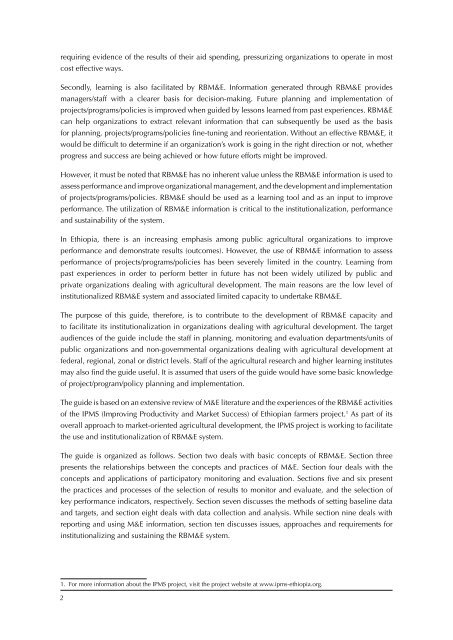A guide for practitioners
A guide for practitioners
A guide for practitioners
Create successful ePaper yourself
Turn your PDF publications into a flip-book with our unique Google optimized e-Paper software.
equiring evidence of the results of their aid spending, pressurizing organizations to operate in mostcost effective ways.Secondly, learning is also facilitated by RBM&E. In<strong>for</strong>mation generated through RBM&E providesmanagers/staff with a clearer basis <strong>for</strong> decision-making. Future planning and implementation ofprojects/programs/policies is improved when <strong>guide</strong>d by lessons learned from past experiences. RBM&Ecan help organizations to extract relevant in<strong>for</strong>mation that can subsequently be used as the basis<strong>for</strong> planning, projects/programs/policies fine-tuning and reorientation. Without an effective RBM&E, itwould be difficult to determine if an organization’s work is going in the right direction or not, whetherprogress and success are being achieved or how future ef<strong>for</strong>ts might be improved.However, it must be noted that RBM&E has no inherent value unless the RBM&E in<strong>for</strong>mation is used toassess per<strong>for</strong>mance and improve organizational management, and the development and implementationof projects/programs/policies. RBM&E should be used as a learning tool and as an input to improveper<strong>for</strong>mance. The utilization of RBM&E in<strong>for</strong>mation is critical to the institutionalization, per<strong>for</strong>manceand sustainability of the system.In Ethiopia, there is an increasing emphasis among public agricultural organizations to improveper<strong>for</strong>mance and demonstrate results (outcomes). However, the use of RBM&E in<strong>for</strong>mation to assessper<strong>for</strong>mance of projects/programs/policies has been severely limited in the country. Learning frompast experiences in order to per<strong>for</strong>m better in future has not been widely utilized by public andprivate organizations dealing with agricultural development. The main reasons are the low level ofinstitutionalized RBM&E system and associated limited capacity to undertake RBM&E.The purpose of this <strong>guide</strong>, there<strong>for</strong>e, is to contribute to the development of RBM&E capacity andto facilitate its institutionalization in organizations dealing with agricultural development. The targetaudiences of the <strong>guide</strong> include the staff in planning, monitoring and evaluation departments/units ofpublic organizations and non-governmental organizations dealing with agricultural development atfederal, regional, zonal or district levels. Staff of the agricultural research and higher learning institutesmay also find the <strong>guide</strong> useful. It is assumed that users of the <strong>guide</strong> would have some basic knowledgeof project/program/policy planning and implementation.The <strong>guide</strong> is based on an extensive review of M&E literature and the experiences of the RBM&E activitiesof the IPMS (Improving Productivity and Market Success) of Ethiopian farmers project. 1 As part of itsoverall approach to market-oriented agricultural development, the IPMS project is working to facilitatethe use and institutionalization of RBM&E system.The <strong>guide</strong> is organized as follows. Section two deals with basic concepts of RBM&E. Section threepresents the relationships between the concepts and practices of M&E. Section four deals with theconcepts and applications of participatory monitoring and evaluation. Sections five and six presentthe practices and processes of the selection of results to monitor and evaluate, and the selection ofkey per<strong>for</strong>mance indicators, respectively. Section seven discusses the methods of setting baseline dataand targets, and section eight deals with data collection and analysis. While section nine deals withreporting and using M&E in<strong>for</strong>mation, section ten discusses issues, approaches and requirements <strong>for</strong>institutionalizing and sustaining the RBM&E system.1. For more in<strong>for</strong>mation about the IPMS project, visit the project website at www.ipms-ethiopia.org.2

















